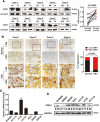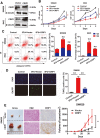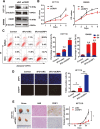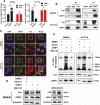Cysteine-rich intestinal protein 1 suppresses apoptosis and chemosensitivity to 5-fluorouracil in colorectal cancer through ubiquitin-mediated Fas degradation
- PMID: 30850009
- PMCID: PMC6408822
- DOI: 10.1186/s13046-019-1117-z
Cysteine-rich intestinal protein 1 suppresses apoptosis and chemosensitivity to 5-fluorouracil in colorectal cancer through ubiquitin-mediated Fas degradation
Abstract
Background: Cysteine-rich intestinal protein 1 (CRIP1) is highly expressed in human intestine and aberrantly expressed in several types of tumor. However, studies on CRIP1 are limited and its role on tumor development and progression remains controversial and elusive.
Methods: Immunohistochemistry was performed to evaluate the expression of CRIP1 in paired normal and colorectal tumor specimens, as well as colorectal cell lines. Functional assays, such as CCK8, TUNEL assay and in vivo tumor growth assay, were used to detect the proliferation, apoptosis and response to 5-FU of CRIP1. Western blot was used to analyze Fas-mediated pathway induced by CRIP1. Rescue experiments were performed to evaluate the essential role of CRIP1 for Fas-mediated apoptosis.
Results: We demonstrated that CRIP1 is overexpressed in CRC tissues compared with adjacent normal mucosa. CRIP1 could dramatically recover the 5-Fluorouracil (5-FU) inhibited CRC cell proliferation in vitro and stimulate the tumor formation of CRC in vivo, probably through inhibiting CRC cell apoptosis. Moreover, CRIP1 also dramatically recovered the 5-Fluorouracil (5-FU) induced tumor cell apoptosis in vitro. Further study demonstrated that CRIP1 down-regulated the expression of Fas protein and proteins related to Fas-mediated apoptosis. CRIP1 could interact with Fas protein and stimulate its ubiquitination and degradation. In addition, a negative correlation was detected between the expression of CRIP1 and Fas protein in most of the clinical human CRC samples.
Conclusion: The current research reveals a vital role of CRIP1 in CRC progression, which provide a novel target for clinical drug resistance of colorectal cancer and undoubtedly contributing to the therapeutic strategies in CRC.
Keywords: Apoptosis; Chemoresistant; Colorectal cancer; Cysteine-rich intestinal protein 1; FAS.
Conflict of interest statement
Ethics approval
All experiments involving patients are endorsed by the Ethics Committee of Southern Medical University and complied with the Declaration of Helsinki. No informed consent was required because data were going to be analyzed anonymously. All animal experiments involved ethical and humane treatment under a license from the Guangdong Provincial Bureau of Science.
Consent for publication
Not applicable.
Competing interests
The authors declare that they have no competing interests.
Publisher’s Note
Springer Nature remains neutral with regard to jurisdictional claims in published maps and institutional affiliations.
Figures






Similar articles
-
Cysteine-Rich Intestinal Protein 1 Silencing Inhibits Migration and Invasion in Human Colorectal Cancer.Cell Physiol Biochem. 2017;44(3):897-906. doi: 10.1159/000485357. Epub 2017 Nov 24. Cell Physiol Biochem. 2017. PMID: 29179181
-
Upregulation of microRNA-135b and microRNA-182 promotes chemoresistance of colorectal cancer by targeting ST6GALNAC2 via PI3K/AKT pathway.Mol Carcinog. 2017 Dec;56(12):2669-2680. doi: 10.1002/mc.22710. Epub 2017 Aug 21. Mol Carcinog. 2017. PMID: 28767179
-
Chemotherapy-induced miR-141/MAP4K4 signaling suppresses progression of colorectal cancer.Biosci Rep. 2018 Dec 21;38(6):BSR20180978. doi: 10.1042/BSR20180978. Print 2018 Dec 21. Biosci Rep. 2018. PMID: 30429233 Free PMC article.
-
The role of microRNAs in 5-FU resistance of colorectal cancer: Possible mechanisms.J Cell Physiol. 2019 Mar;234(3):2306-2316. doi: 10.1002/jcp.27221. Epub 2018 Sep 7. J Cell Physiol. 2019. PMID: 30191973 Review.
-
MicroRNAs and Apoptosis in Colorectal Cancer.Int J Mol Sci. 2020 Jul 28;21(15):5353. doi: 10.3390/ijms21155353. Int J Mol Sci. 2020. PMID: 32731413 Free PMC article. Review.
Cited by
-
CRIP1 cooperates with BRCA2 to drive the nuclear enrichment of RAD51 and to facilitate homologous repair upon DNA damage induced by chemotherapy.Oncogene. 2021 Aug;40(34):5342-5355. doi: 10.1038/s41388-021-01932-0. Epub 2021 Jul 14. Oncogene. 2021. PMID: 34262130 Free PMC article.
-
Single-cell transcriptomic and T cell antigen receptor analysis of human cytomegalovirus (hCMV)-specific memory T cells reveals effectors and pre-effectors of CD8+- and CD4+-cytotoxic T cells.Immunology. 2024 Jul;172(3):420-439. doi: 10.1111/imm.13783. Epub 2024 Mar 19. Immunology. 2024. PMID: 38501302 Free PMC article.
-
CRIP1 involves the pathogenesis of multiple myeloma via dual-regulation of proteasome and autophagy.EBioMedicine. 2024 Feb;100:104961. doi: 10.1016/j.ebiom.2023.104961. Epub 2024 Jan 9. EBioMedicine. 2024. PMID: 38199044 Free PMC article.
-
β2 Integrins differentially regulate γδ T cell subset thymic development and peripheral maintenance.Proc Natl Acad Sci U S A. 2020 Sep 8;117(36):22367-22377. doi: 10.1073/pnas.1921930117. Epub 2020 Aug 26. Proc Natl Acad Sci U S A. 2020. PMID: 32848068 Free PMC article.
-
Major vault protein (MVP) suppresses aging- and estrogen deficiency-related bone loss through Fas-mediated apoptosis in osteoclasts.Cell Death Dis. 2023 Sep 13;14(9):604. doi: 10.1038/s41419-023-05928-4. Cell Death Dis. 2023. PMID: 37704623 Free PMC article.
References
MeSH terms
Substances
LinkOut - more resources
Full Text Sources
Medical
Molecular Biology Databases
Research Materials
Miscellaneous

